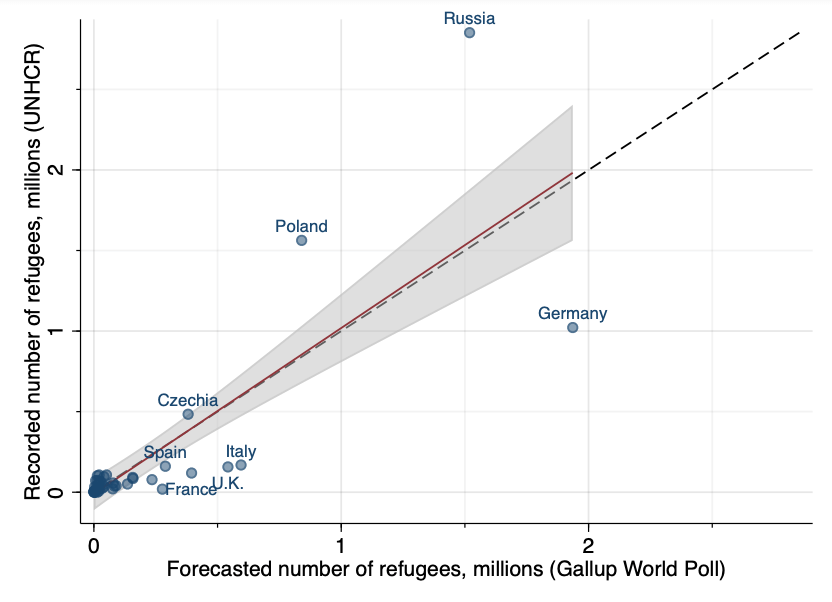Since the beginning of the full-scale war one year ago, eight million Ukrainians have left the country. But how many Ukrainians want to leave the country permanently? And to which destination countries? According to survey data from the Gallup World Poll (2022), another four million Ukrainians would still like to leave the country if they had the opportunity. Moreover, many of those that have left would prefer to stay permanently in their new host country.
Since Russia launched its full-scale invasion of Ukraine on February 24, 2022, approximately one third of the Ukrainian population have been forced to leave their homes. One year after the invasion, 8 million Ukrainian refugees are recorded across Europe and 7 million people are internally displaced within Ukraine, according to UNHCR (2023). The number of border crossings is even larger, with 19 million crossings from—and 10 million to—Ukraine. A majority (5 million) of Ukrainians who have left the country are registered for Temporary Protection or similar protection schemes in Europe, with Poland (1.6 million), Germany (1.1 million) and Czechia (0.5 million) being the top-3 destination countries within the European Union (EU)—see Table 1. At the same time, the number of Ukrainian refugees in Russia is estimated to be almost 3 million. This number, however, includes both voluntary migration and forced deportations.
Table 1. Number of Ukrainian refugees recorded across Europe on February 21, 2023: Top-10 destination countries.
| Rank | Country | Number of refugees |
| 1 | Russia | 2,852,000 |
| 2 | Poland | 1,563,000 |
| 3 | Germany | 1,055,000 |
| 4 | Czechia | 489,000 |
| 5 | Italy | 170,000 |
| 6 | Spain | 168,000 |
| 7 | United Kingdom | 163,000 |
| 8 | France | 119,000 |
| 9 | Romania | 110,000 |
| 10 | Slovakia | 110,000 |
Note: Numbers rounded to nearest thousand. Source: UNHCR (2023).
How do these numbers correspond to the Ukrainians’ own preferences? That is, how many have already reached their preferred destination country, and how many would like to continue migrating onwards? How many would eventually like to return to Ukraine, and how many would prefer to stay permanently in their new host country?
Measuring Ukrainian migration preferences
In a new study in the International Migration Review (Elinder, Erixson and Hammar 2023), we analyze migration preferences in Ukraine using survey data from the Gallup World Poll (GWP). Since 2006, GWP has interviewed randomly-selected and nationally-representative samples of at least 1,000 individuals per country and year in more than 160 countries all over the world (Gallup 2022). Among other things, GWP asks the following question “Ideally, if you had the opportunity, would you like to move permanently to another country, or would you prefer to continue living in this country?”, and to those who would like to move also “To which country would you like to move?”. We use these survey data to measure migration aspirations and destination-country preferences in Ukraine between 2007 and 2021, that is, before the start of the full-scale war.
Our results show that, between 2007 and 2021, on average 26.2 percent of the Ukrainian population, that is, approximately 11.6 million Ukrainians (calculated as the share wishing to emigrate times the Ukrainian population of 44.1 million in 2020), said that they wanted to move permanently to another country if they had the opportunity. The most popular EU countries were Germany, Poland, and Italy. Most popular countries outside of the EU were the United States, Russia, and Canada. Relative to its population size, Czechia was the most popular country. The top-10 most popular destination countries are presented in Table 2.
Table 2. Number of Ukrainians who would like to move permanently to different countries: Top-10 destination countries.
| Rank | Country | Number of Ukrainians | Share of population |
| 1 | Germany | 1,936,000 | 2.3% |
| 2 | United States | 1,704,000 | 0.5% |
| 3 | Russia | 1,519,000 | 1.1% |
| 4 | Poland | 840,000 | 2.2% |
| 5 | Canada | 682,000 | 1.8% |
| 6 | Italy | 595,000 | 1.0% |
| 7 | United Kingdom | 542,000 | 0.8% |
| 8 | France | 395,000 | 0.6% |
| 9 | Czechia | 381,000 | 3.6% |
| 10 | Spain | 289,000 | 0.6% |
Note: This table shows the global distribution of Ukrainian refugees under the assumption that they could move to any country in the world and distribute themselves according to their destination country preferences. Share of population refers to the percentage of estimated Ukrainian refugees relative to the population of the destination country in 2020. Calculations are based on migration aspirations and destination country preferences from the GWP 2007–2021 and country populations in 2020 from the World Development Indicators (World Bank 2022). Numbers rounded to nearest thousand. Source: Elinder, Erixson and Hammar (2023).
Comparing current and prospective number of refugees
If we compare the current numbers of Ukrainian refugees across Europe (Table 1) with the number of Ukrainians who wanted to move to different countries (Table 2), we find a very strong correlation between these numbers—see Figure 1. At the same time, we can also see that in some countries, in particular the neighboring countries Russia and Poland, the current number of Ukrainian refugees is much higher than the number of Ukrainians who wanted to move there. In other countries, notably Germany, the current number of Ukrainians are still fewer than those who wished to move there. A possible interpretation of this comparison is that currently there are approximately 1.3 million Ukrainians in Russia who did not have this as their preferred destination (calculated as the difference between the current number of Ukrainian refugees in Russia and the number of Ukrainians who wished to move to Russia), which partly can also be explained by forced deportations. In Poland, there are around 700,000 Ukrainians (the difference between the numbers in Table 1 and Table 2) who have not yet reached their preferred destination and, as such, are likely to continue migration onwards or eventually returning to Ukraine. Germany, on the other hand, might expect another 900,000 Ukrainians to arrive—if they follow their preferences.
Figure 1. Forecasted versus recorded number of Ukrainian refugees across Europe on January 24, 2023.
Note: The x-axis shows our predicted number of Ukrainian refugees across destination countries in the global case where Ukrainian refugees could go anywhere (Table 2). The y-axis shows the actual number of Ukrainian refugees recorded across Europe according to UNHCR (2023) as of January 24, 2023 (Table 1). Each point represents a destination country. The dashed line shows the 45-degree line where the predicted and the actual number of refugees are the same: observations above that line are countries where the current number of recorded refugees is higher than the predicted number, while observations below the line are countries where the predicted number of refugees is higher than the actual number. The red line shows a linear fit prediction with 95 percent confidence intervals. Source: Elinder, Erixson and Hammar (2023). Updated on January 24, 2023.
A preliminary analysis of the 2022 GWP data
Finally, we can also say something about the most recent GWP data, which was collected in Ukraine in September 2022, that is, during the ongoing war. Of the Ukrainians remaining in Ukraine in September 2022, 10 percent answered that they would like to leave Ukraine permanently if they had the opportunity. This implies that approximately 4 million Ukrainians with migration aspirations still remained in Ukraine. When it comes to preferred destination countries, none of those remaining wanted to move to Russia. Preferred countries were then Canada (20 percent), Poland (17 percent), the United States (17 percent), Czechia (9 percent), and Germany (8 percent).
Concluding remarks
Millions of Ukrainians have been forced to leave their homes due to the Russian invasion and are now seeking protection in the EU and other countries. Many of these refugees will return to Ukraine as soon as they can. But, given their aspirations and preferences, it is also likely that many would like to stay permanently in their new host countries. Understanding these preferences is important for long-term integration policies in the destination countries as well as for postwar Ukrainian reconstruction plans. For EU and the Ukrainian refugees, a crucial question is what will happen after the Temporary Protection ends?
References
Elinder, Mikael, Oscar Erixson and Olle Hammar (2022). “How large will the Ukrainian refugee flow be, and which EU countries will they seek refuge in?”, Delmi Policy Brief 2022:3. Stockholm: Migration Studies Delegation.
Elinder, Mikael, Oscar Erixson and Olle Hammar (2023). “Where would Ukrainian refugees go if they could go anywhere?”, International Migration Review, forthcoming. https://doi.org/10.1177/01979183221131559.
Gallup (2022). Worldwide Research: Methodology and Codebook. Updated August 2022.
UNHCR (2023). “Ukraine refugee situation”, Operational Data Portal. https://data.unhcr.org/en/situations/ukraine (accessed on January 24, 2023).
World Bank (2022). “World development indicators”, DataBank. https://databank.worldbank.org/source/world-development-indicators (accessed on July 7, 2022).
Note. This column is based on an article forthcoming in the International Migration Review and a Migration Studies Delegation (Delmi) policy brief.
Attention
The authors do not work for, consult to, own shares in or receive funding from any company or organization that would benefit from this article, and have no relevant affiliations






